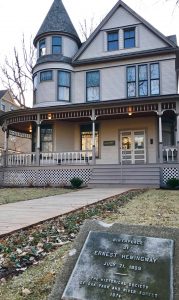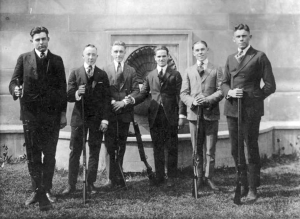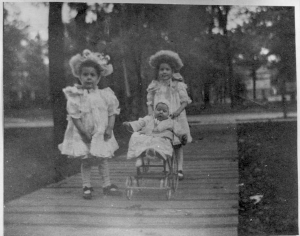Hemingway Oak Park graduation party to celebrate 100 years
By Jean Lotus Staff Reporter — June 13, 2017
The Queen Anne-style Hemingway birth home, 339 N. Oak Park Ave. in Oak Park. (Photo courtesy of Ernest Hemingway Foundation of Oak Park)
In 1917, the young high school graduate calling himself “Hemingstein” lied to some of his friends that he planned to attend University of Illinois.
But Ernest Hemingway, Oak Park’s most conflicted native son, had no intention of going to college, said Steve Paul, retired Kansas City Star arts editor and author of an upcoming book “Hemingway at Eighteen: The Pivotal Year That Launched an American Legend.”
President Woodrow Wilson had just committed the United States to war in Europe in April, and Hemingway knew his poor eyesight and his parents’ strong objections would block him from enlisting.
“Ernie spent a summer of indecision at the family cabin in Michigan, farming, fishing and hanging out with friends,” said Paul. Then an uncle pulled strings to snag a cub-reporter job at the Kansas City Star, and Hemingway saw a path to leave Oak Park and see the world.
The Ernest Hemingway Foundation of Oak Park will celebrate the 100th anniversary of Hemingway’s high school graduation at the Oak Park Hemingway Museum, the evening of Saturday, June 17. The party will feature music of the era performed by the Oak Park and River Forest High School Jazz Ensemble and the foundation’s Hemingway Essay prize will be awarded to a high school junior.
Although there are other Hemingway collections in Boston and Texas, and other Hemingway societies in Florida and Cuba, Oak Park’s Hemingway archives are unique. This is because the collection was cultivated over decades by relationships with Hemingway family members and private collectors, said Emily Reiher, archivist at Oak Park Public Library, where most of the artifacts are kept. That, and the fact that the Hemingway family saved everything, said John F. Berry, the foundation’s board president.
“Grace Hall Hemingway, his mother, had so many family artifacts and photos. She never threw anything away,” Berry said. Most of the archives’ images of Hemingway’s early life and family members in Oak Park can be seen online in the digital archives of the Illinois State Library.

Phony high school ‘Trap Shooters Club’ photo with Ernest Hemingway (left) and classmates. (Photo courtesy of Ernest Hemingway Foundation of Oak Park Archives)
Ernest Hemingway was the second of six children born in 1899 to Grace Hall, an opera singer, music teacher and artist and obstetrician Dr. Clarence Hemingway. All four grandparents lived in Oak Park.
Grace Hemingway delighted in dressing young Ernest and his older sister Marcelline as twins, sometimes as girls and sometimes as boys, up until about second grade.
“That’s the central trauma of his upbringing, according to some scholars. Or maybe it was just a charming Victorian custom,” said Robert K. Elder, author of the photo-laden coffee table book “Hidden Hemingway: Inside the Earnest Hemingway Archives of Oak Park,” published last year.
On graduation day in June, 1917, Ernest was joined by Marcelline who was held back in school for some reason. The school was then called Oak Park and River Forest Township High School.
The Hemingway siblings’ high school years are documented in the “Trapeze,” the student newspaper and the literary magazine “Tabula.” Marcelline was a better student, Reiher said. “She got the A and he got a B or C on the same assignments,” she said. Marcelline did go on to attend college, at Oberlin in Ohio.
“Ernest’s ambition was evident,” Elder said. “He’s is in nearly every photo in the yearbook: football, swimming team. He participated in sports but he wasn’t necessarily very good at them. When he ran on the track team, he threw up.” Elder thinks Hemingway’s photos show he was “an outsider, physically large, but he had not grown into his body yet. He’s bigger than everybody.”
Inspired by high school English teacher Fannie Biggs, Hemingway wrote poetry, short stories and sports coverage in the manner of his stylistic hero Ring Lardner. He was also a fan of Rudyard Kipling and Stewart Edward White, an adventure naturalist, Elder said. At school he was known to have a sense of humor. His high school friends, mostly white European-derived Protestants, called each other by “Jewish-sounding nicknames, for some reason,” Elder said. “Late into life he would sign his name as ‘Hemingstein,’ with a little drawing of a stein of beer.”

Ernest and Marcelline Hemingway as high school seniors in 2018. (Photo courtesy of Ernest Hemingway Foundation of Oak Park Archives)
The group of pranksters even invented a phony “Trap Shooters Club” and posed for a false club photo in the school newspaper, Elder said. “No one in the group other than Hemingway even owned a shotgun,” he said.
Reputedly, Hemingway was not interested in many girls in high school. He took Marcelline to the Junior Prom. But Elder found a passionate adolescent love poem in the Oak Park archives dedicated to classmate Annette DeVoe.
“Your Matchless grace your sensuous loveliness and your beauty strikes me dumb,” it says. “Oh God, I love you Annette.”
Elder also discovered an unrequited torch that Hemingway seems to have carried for classmate Frances Coates.
“He was lovesick Hemingway. He wrote her letters from Italy, but she was already engaged to someone else. She put him squarely in the friend-zone.”
As a boy, Hemingway sang in the choir where his parents attended the Congregationalist Church on Lake Street, but he later chafed at the religious conformity of teetotaling Oak Park, “dry” since 1902.
In his adolescence he and his friends fished and boated in the Des Plaines River. They enjoyed nature hikes, Elder said. His father was a devoted outdoorsman and fisherman and the family had a cabin on Walloon Lake in northern Michigan.
The Michigan summer launched Hemingway into his “pivotal 18th year” where he apprenticed at the Kansas City Star and then crossed the Atlantic as a volunteer to drive a Red Cross ambulance in Italy and was seriously wounded by a mortar shell, Paul said.
It started in Michigan at the cabin.
“There are tense letters between Ernest and his parents, who are sort of throwing up their hands at his unruly behavior. He couldn’t wait to get out from under their influence,” Paul said.
Chicago’s loss was Kansas City’s gain — and the world’s, Paul said. At the Star, Hemingway was exposed to writing on a deadline at a newspaper that “was very permissive and had a creative approach to writing,” Paul said. Although the articles of the time didn’t always have bylines, Hemingway’s work has been identified for the half a year he spent in newspapering. Some were routine news stories, but some have a “real sense of narrative,” he said.
“The apprenticeship at the Star allowed him access to the world where he could learn everything and anything he wanted and he was able to cram a great amount of education into that time.”
In Kansas City, Hemingway met and interviewed Ted Brumback, a volunteer Red Cross ambulance driver who had just returned from France. Brumback published a first-person account of his European experiences near the battlefields, possibly with some editing or writing help from Hemingway, Paul said.

Ernest and Marcelline and baby Ursula Hemingway in Oak Park in 1903, dressed in twin outfits by their mother. (Photo courtesy of Ernest Hemingway Foundation of Oak Park Archives)
By then, Hemingway had decided to join Brumback on a volunteer Red Cross mission in Italy.
When he got to Italy, it is not clear Hemingway actually did get to drive an ambulance, Paul’s research showed. Hemingway was at the front only a few weeks, possibly delivering food and chocolate to Italian troops, when he was struck by a mortar and pierced by more than 250 pieces of shrapnel. In the months of convalescence in an Italian hospital, he met and fell in love with nurse Agnes von Kurowsky, an older woman at age 26. That love affair was the inspiration for “A Farewell to Arms.”
Von Kurowsky’s “Dear John” letter is featured in the Oak Park Ernest Hemingway Museum, at 200 N. Oak Park Ave.
“Ernie, dear boy,
I am writing this late at night after a long think by myself, & I am afraid it is going to hurt you, but, I’m sure it won’t harm you permanently,” Agnes wrote. Then she casually dropped the fact that she was marrying someone else.
Ernest returned home to Oak Park to recuperate, filled with tall tales of the war that Paul calls “little white lies that compounded in on themselves.”
“He came home wounded and they still treated him like a kid,” Elder said. He shortly moved to Chicago. In 1921, he and first wife, Hadley, moved to Paris, with Sherwood Anderson’s letters of introduction to Gertrude Stein and Ezra Pound.
Hemingway only returned to Oak Park once, after his father’s suicide in 1928. He quarreled with Marcelline and rekindled a strong hatred for his mother, whom he accused of browbeating his father into his “cowardly act.”
“His third wife said, ‘never marry a man who hates his mother,’” Elder said.
But even though Ernest never returned, Oak Park considers him a native son.
The Ernest Hemingway Museum graduation party will kick off a new chapter for the EHFOP, John Berry said.
The foundation owns the Queen Anne Hemingway birth home across the street at 339 N. Oak Park Ave. The Hemingway museum and birth home attract about 8,000 visitors yearly, from around the world, Berry said.
Plans for a $1.1 million writer’s center built behind the birth home mean the foundation will close the museum at the end of the year, and transfer the artifacts to the library.
But before that happens, the museum will host Paul’s debut book reading of “Hemingway at Eighteen” in October, he said. The book is being published by Chicago Review press.
Hemingway spent his later life in Europe, Africa, Florida and Cuba, ultimately dying by suicide in Idaho. But Oak Park is where his earliest ambitions were born, Elder said.
In the Oak Park archives, Elder found an assignment of Ernest’s from high school listing favorite activities, favorite flowers and sports.
“And there, on the bottom, almost half-erased it says, ‘I intend to travel and write.’ And that’s really what he did.”
Read the current issue of the Cook County Chronicle
Free subscription to the digital edition of the Cook County Chronicle
— Hemingway Oak Park graduation party to celebrate 100 years —



